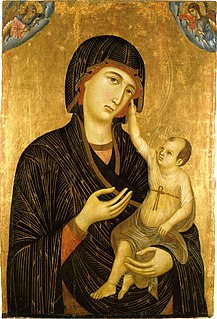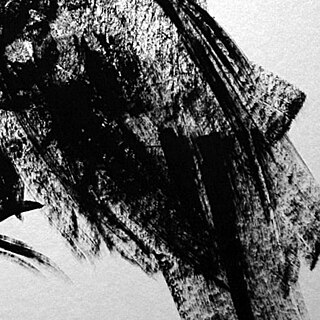
An oil dipper is used to hold a supply of turpentine, oil or painting medium, fastened to the painter's palette. [1]
Used in oil painting, it can be clipped onto the edge of the wooden palette.
- ↑ Collier, John. A Manual of Oil Painting. p. 15.

An oil dipper is used to hold a supply of turpentine, oil or painting medium, fastened to the painter's palette. [1]
Used in oil painting, it can be clipped onto the edge of the wooden palette.

Georges Braque was a major 20th-century French painter, collagist, draughtsman, printmaker and sculptor. His most important contributions were in his alliance with Fauvism from 1905, and the role he played in the development of Cubism. Braque's work between 1908 and 1912 is closely associated with that of his colleague Pablo Picasso. Their respective Cubist works were indistinguishable for many years, yet the quiet nature of Braque was partially eclipsed by the fame and notoriety of Picasso.

Jan Josephszoon van Goyen was a Dutch landscape painter. Van Goyen was an extremely prolific artist; approximately twelve hundred paintings and more than one thousand drawings by him are known.

Oil painting is the process of painting with pigments with a medium of drying oil as the binder. Commonly used drying oils include linseed oil, poppy seed oil, walnut oil, and safflower oil. The choice of oil imparts a range of properties to the oil paint, such as the amount of yellowing or drying time. The paint could be thinned with Turpentine. Certain differences, depending on the oil, are also visible in the sheen of the paints. An artist might use several different oils in the same painting depending on specific pigments and effects desired. The paints themselves also develop a particular consistency depending on the medium. The oil may be boiled with a resin, such as pine resin or frankincense, to create a varnish prized for its body and gloss. The paint itself can be molded into different textures from the plasticity that it contains. Before oil painting was fully discovered egg tempera was commonly used. Tempera did not have the flexibility in pigment that oil paints provided.

En plein air, or plein air painting, is the act of painting outdoors.

Tempera, also known as egg tempera, is a permanent, fast-drying painting medium consisting of colored pigments mixed with a water-soluble binder medium, usually glutinous material such as egg yolk. Tempera also refers to the paintings done in this medium. Tempera paintings are very long-lasting, and examples from the first century AD still exist. Egg tempera was a primary method of painting until after 1500 when it was superseded by oil painting. A paint consisting of pigment and binder commonly used in the United States as poster paint is also often referred to as "tempera paint", although the binders in this paint are different from traditional tempera paint.
A palette knife is a blunt tool used for mixing or applying paint, with a flexible steel blade. It is primarily used for applying paint to the canvas, mixing paint colors, adding texture to the painted surface, paste, etc., or for marbling, decorative endpapers, etc. The "palette" in the name is a reference to an artist's palette which is used for mixing oil paint and acrylic paints.

Pointillism is a technique of painting in which small, distinct dots of color are applied in patterns to form an image.

Oil paint is a type of slow-drying paint that consists of particles of pigment suspended in a drying oil, commonly linseed oil. The viscosity of the paint may be modified by the addition of a solvent such as turpentine or white spirit, and varnish may be added to increase the glossiness of the dried oil paint film. Oil paints were first used in Asia as early as the 7th century AD, and can be seen in examples of Buddhist painting in Afghanistan. Oil based paints made their way to Europe by the 12th century and were used for simple decoration, but did not begin to be adopted as an artistic medium there until the early 15th century. Common modern applications of oil paint are in finishing and protection of wood in buildings and exposed metal structures such as ships and bridges. Its hard-wearing properties and luminous colors make it desirable for both interior and exterior use on wood and metal. Due to its slow-drying properties, it has recently been used in paint-on-glass animation. Thickness of coat has considerable bearing on time required for drying: thin coats of oil paint dry relatively quickly.

Grisaille is a painting executed entirely in shades of grey or of another neutral greyish colour. It is particularly used in large decorative schemes in imitation of sculpture. Many grisailles include a slightly wider colour range, like the Andrea del Sarto fresco illustrated. Paintings executed in brown are referred to as brunaille, and paintings executed in green are called verdaille.

Sgraffito is a technique either of wall decor, produced by applying layers of plaster tinted in contrasting colours to a moistened surface, or in pottery, by applying to an unfired ceramic body two successive layers of contrasting slip or glaze, and then in either case scratching so as to reveal parts of the underlying layer. The Italian past participle "sgraffiato" is also used, especially of pottery.

Drybrush is a painting technique in which a paint brush that is relatively dry, but still holds paint, is used. Load is applied to a dry support such as paper or primed canvas. The resulting brush strokes have a characteristic scratchy look that lacks the smooth appearance that washes or blended paint commonly have.
Corel Painter Essentials is a home software studio for turning photographs into paintings. Corel Painter Essentials is now in its 7th incarnation.

Self-Portrait with Palette is an 1878–79 oil-on-canvas painting by the French artist Édouard Manet. This late impressionistic work is one of his two self-portraits. Velasquez's self-portrait in Las Meninas was a particular inspiration for Manet's painting which despite its allusion to the previous artist's work is very modern in its focus upon the personality of the artist and loose paint handling.

Jimson Weed is an oil on linen painting by American artist Georgia O'Keeffe from 1936, located in the Indianapolis Museum of Art in Indianapolis, Indiana. It depicts four large blossoms of jimson weed. A similar work by O'Keeffe, Jimson Weed/White Flower No. 1, was sold by the Georgia O'Keeffe Museum at auction to Walmart heiress Alice Walton in 2014 for $44,405,000, more than tripling the previous world auction record for a piece by a female artist.

Ma Jolie is an oil on canvas painting by Spanish artist Pablo Picasso, which is located in the Indianapolis Museum of Art, in Indianapolis, Indiana, US. Completed in 1914, its fractured depiction of everyday objects is an example of Cubism. It is not to be confused with the 1912 Picasso of the same name, which is now in the Museum of Modern Art in New York.

Girl Running on Balcony is a 1912 painting by Giacomo Balla, one of the forerunners of the Italian movement called Futurism. The piece indicates the artist's growing interests in creative nuances which would later formally be realized as part of the Futurist movement. The artist was influenced heavily by northern Italians' use of divisionism and the French's better known pointillism. Created with oil on canvas just on the brink of World War I, the Futurist movement is embodied by a dark optimism for a future of speed, turbulence, chaos, and new beginnings. Most of Giacaomo Balla's pieces allude to the wonder of dynamic movement, and this painting is no exception. The oil painting is currently housed at the Galleria d'Arte Moderna (GAM) in Milan.

The Forest in Winter at Sunset is a mid-19th century oil painting by Théodore Rousseau. The painting, which depicts a forested landscape in wintertime, is currently on display at the Metropolitan Museum of Art.

Acrobat and Young Harlequin is a 1905 oil on canvas painting by Pablo Picasso. Painted toward the end of Picasso's Blue Period and the outset of his Rose Period, the work displays characteristics of both, with its melancholic subject and its blue and rose palette. Picasso created the painting while at the Le Bateau-Lavoir, his home and studio in Montmartre, Paris.

The Hanged Man's House is an 1873 oil on canvas painting by Paul Cézanne. The painting is exhibited at the Musée d'Orsay in Paris.

Girl in a Chemise is an oil on canvas painting by Pablo Picasso, which he painted c.1905. It is a portrait of a girl, whom experts believe to be Madeleine, Picasso's girlfriend during this period. Stylistically, the painting belongs to Picasso's Rose Period, although it is predominantly blue in tone. The painting is particularly remarkable for the presence of an earlier portrait of a young boy hidden beneath the surface, which Picasso transformed into the girl by making some subtle changes. The portrait has been housed in the collection of the Tate since 1933.